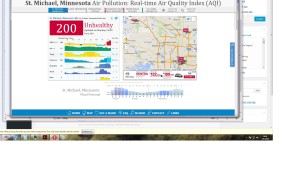http://aqicn.org/city/usa/minnesota/st.-michael/
The Air Quality Index this afternoon has reached 200 in St. Michael, MN, and above 190 in multiple locations including
Minneapolis–Near Road 190
Minneapolis–Phillips 196
Apple Valley 191
The MPCA’s numbers are a little different but still very high.
The MPCA says this:
Note: This air quality health alert now covers the entire state of Minnesota, including the Twin Cities area.
Heavy smoke from Canadian wildfires is slowly moving across Minnesota today. As of 3:00 p.m., fine particle levels had reached unhealthy levels in a diagonal band across the state including: Marshall, St. Cloud, Brainerd, Duluth and Grand Portage. This band of smoke is expected to continue to move across the state Monday evening and into the early morning hours Tuesday. Cleaner air is entering the state behind the smoke plume, resulting in improved air quality.
It does appear that cleaner air is behind the current pulse of smoke and conditions are starting to improve beginning in the Northwest part of the state. See the trend on this map:
An AQI of 200 is at the very top of the “Unhealthy” range (CODE RED)
The “Very Unhealthy” range (CODE PURPLE) begins at 201.
Many people with asthma and other air-quality-sensitive health conditions will be in distress. Information from the American Lung Association here.
An AQI this high has not recently, if at all, been recorded in Minnesota.
A key point is that when air quality gets this bad, regardless of the primary cause, all available steps need to be taken to curtail other, contributing pollution sources. As far as I know, the State of Minnesota has no plans in place to do this. Instead we tell people, in effect, to “stay inside and don’t breathe deeply.” This reflects industrial influence over environmental and public health agencies.



No comments yet.